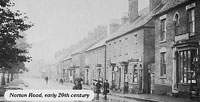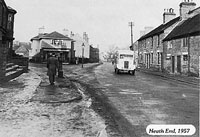Pelsall in history

Pelsall was first mentioned in a charter of 994, when it was amongst various lands given to the monastery at Heantune (Wolverhampton) by Wulfrun, a Mercian noblewoman. At this time it was called Peolshalh, meaning 'a nook' or 'land between two streams belonging to Peol'. The Domesday entry of 1086 describes it as being waste, still belonging to the Church. This part of Staffordshire had probably been devastated in 1069 by King William's forces when dealing with the uprising following the Norman Conquest.
Very little is known about the village during the ensuing centuries, but as a chapel of ease was built in c.1311, it must be assumed that a settlement had been established there by then. The population was small and a return of 1563 lists only 14 householders. The economy at that time would have been agrarian and evidence of the medieval strip farming system can still be seen on the tithe map of c.1840. The original centre of the village was the area now known as Old Town. In 1760 the remaining open fields were enclosed, but some holdings survived into the next century in Hall Field, High Ley, The Riddings Field and Final Field.
By the second quarter of the 19th century Pelsall had a more scattered appearance, with clusters of houses developing on the fringes of the extensive commonland and at the Newlands. The greatest concentration were in what is now the village centre. This area gradually developed; a Methodist Chapel and school were opened in c.1836, in the modern day Station Road and a new St.Michael's Church was built in 1844 - the former in Paradise Lane had been considered too small for the growing population. Towards the end of the 19th century shops became established in Norton Road and High Street. The population in 1801 was 477 and by 1901 had grown to 3,626.
Pelsall had become a mining village; in places deposits of coal were found only a few yards from the surface and c.1800 the shallow and deep seams were 'much worked'. The cutting of the canal in c.1794 had opened up the area for industrialisation, with entrepreneurs and landowners quickly exploiting the mineral wealth. Nailmaking, traditionally a cottage industry was also carried out locally; in the census of 1841 thirty men gave this as their occupation.

An ironworks was established on the North Common which grew into a sizeable concern under the ownership of Messrs. Davis and Bloomer. This, together with Yorks Foundry and that of Ernest Wilkes and Co. at Mouse Hill, gave Pelsall a share of the heavy iron trade during the 19th century. Ernest Wilkes and Co. survived until 1977, but the others ceased trading in the 1890's and the pits became unworkable mainly due to continual flooding problems.
The village managed to keep its rural atmosphere well into the 20th century, with several working farms surviving until after the Second World War. Since then much land has been utilised for housing development but the ancient common remains.
Walsall Local History Centre